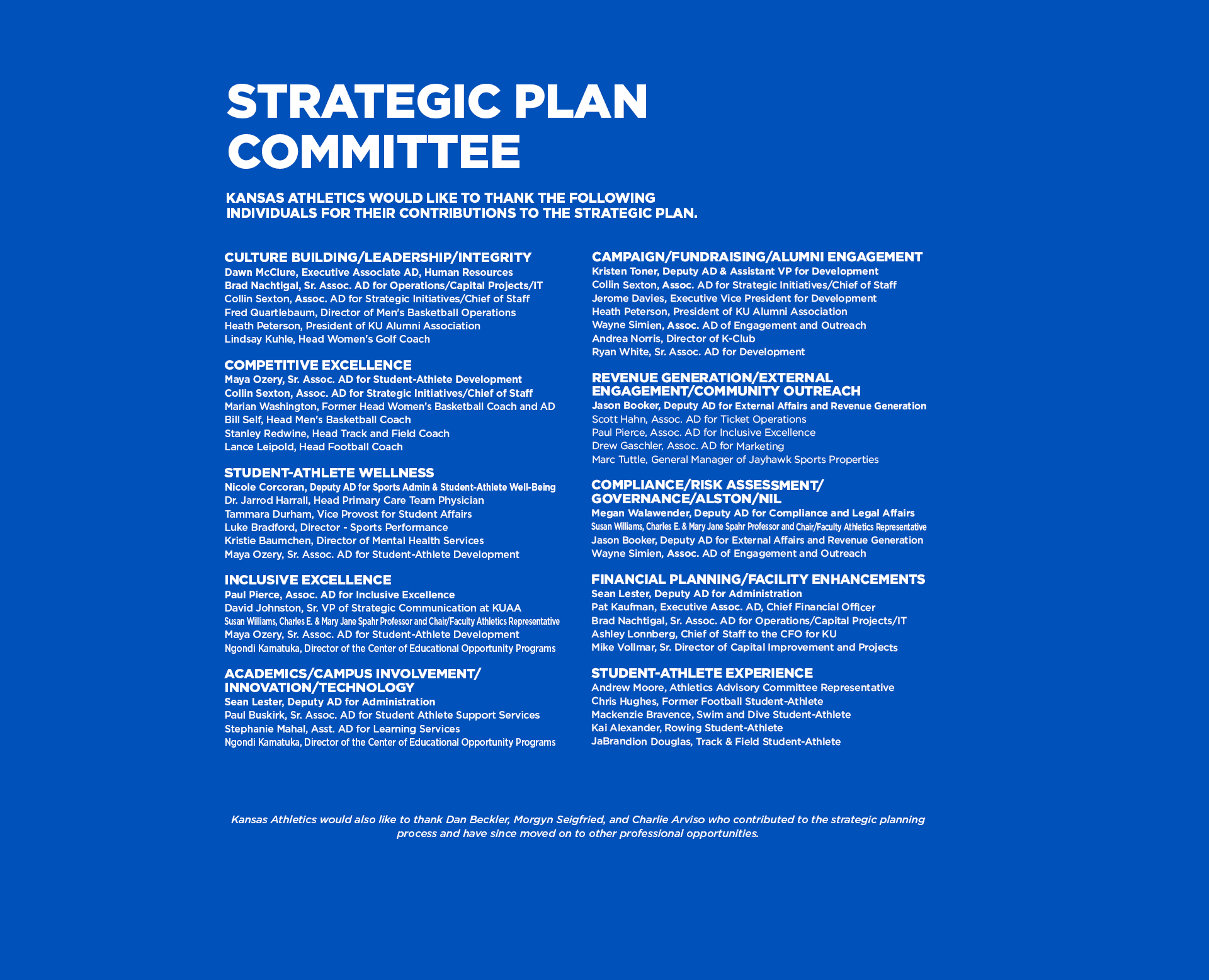
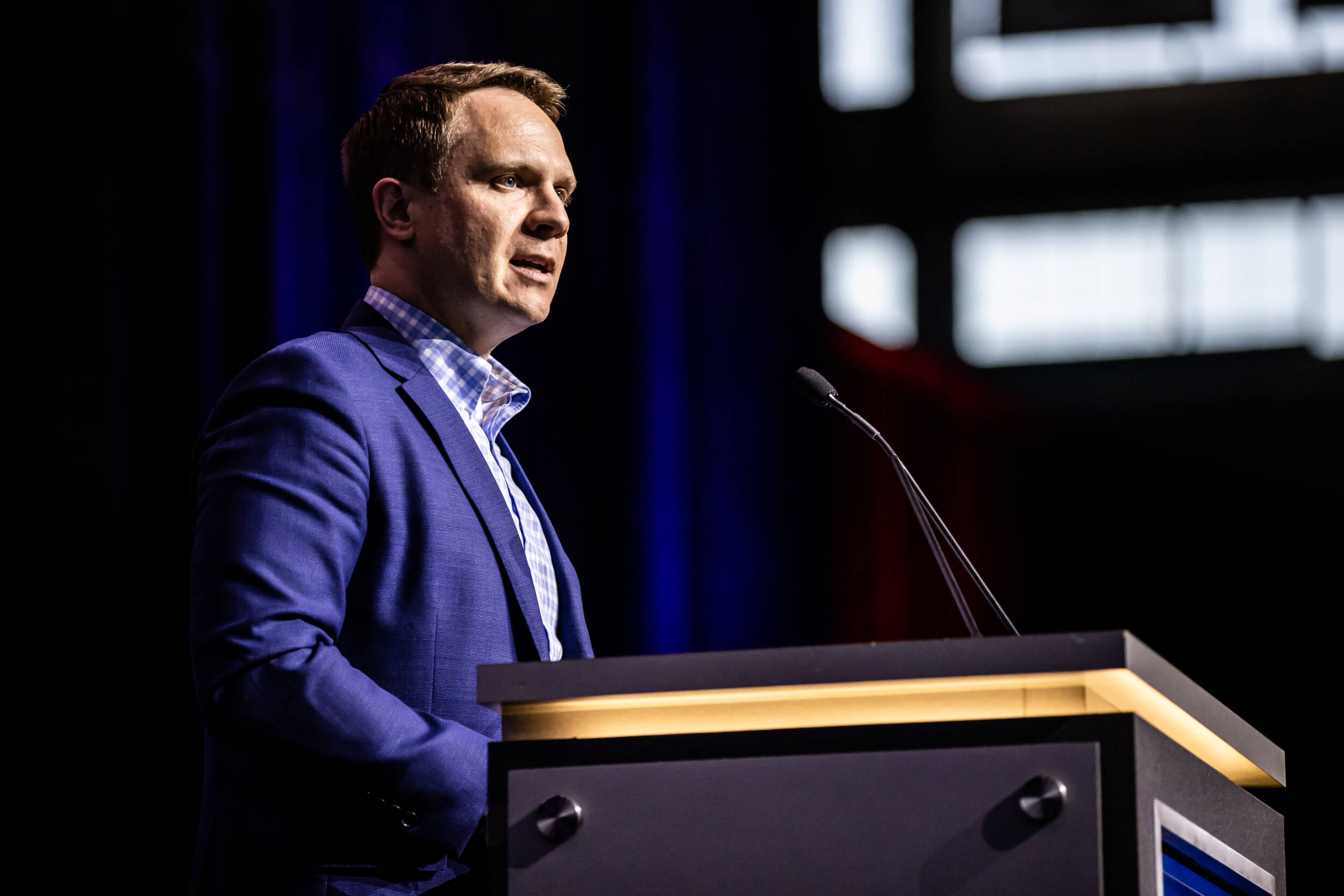
Dear Jayhawks,
There has never been a better time to be a Kansas Jayhawk. The combination of our tradition and trajectory, along with the awe-inspiring support from our university leadership, fans and alumni, signifies there is no limit on the potential of Kansas Athletics.
In that spirit, it is with great excitement and conviction that we share our strategic plan, which provides our roadmap to continued success for the University of Kansas. We are honored to use the phrase “To the Stars” as the title of our strategic plan, which is a nod to our state’s motto, “Ad Astra per Aspera” – to the stars through difficulties.
We are navigating a profoundly shifting landscape in higher education and college athletics. It is essential that the University of Kansas continues to cement its place as a national leader now and in an unpredictable future.
We embrace challenges and the unknown, while combining our legacy with a progressive approach to the new realities of college athletics. We proudly support the defending national champions in Kansas Men’s Basketball; a program that holds the most wins and strongest brand in the sport. We understand the impact that program has on our greater institution and will continue to invest in this crown jewel in an unrivaled manner. We are steadfast in seeking the unrealized potential of KU Football and will continue to boldly create a path to sustained success in that critical program. We are excited about the future of David Booth Kansas Memorial Stadium and the immeasurable impact that a multipurpose project at 11th and Mississippi streets will have on our football program, the campus and Lawrence communities and our supporters.
As we look to the future, it is clear that a strong athletics program makes a profound impact on the broader institution. Success in competition, in particular in football and men’s basketball, elevates enrollment to record numbers and dramatically increases alumni engagement, pride and support. Further, they drive critical resources that allow us to invest in ALL 16 of our athletic programs, thereby benefitting 500 student-athletes. This strategic plan honestly addresses the importance of those two programs and their impact on the University of Kansas.
Even with success, we will not concede. We will never rest on our laurels and will embrace change. As we have entered the new era of name, image and likeness (NIL), we have been innovative and comprehensive in our approach. We are insistent our student-athletes have groundbreaking opportunities those before them did not.
We are prepared to undertake additional capital projects that will provide our programs with the needed facilities to continue to compete at the highest level. We will embark on a renovation to Allen Fieldhouse — the most historic basketball arena in college basketball — while maintaining its tradition. We will expand and renovate the Anderson Family Football Complex to ensure it fulfills the day-to-day developmental needs of our football student-athletes.
This strategic plan focuses on our values, inclusive excellence, student-athlete wellness and experience, community engagement, philanthropy, financial sustainability and other critical areas for success. It outlines how we serve as a national leader in compliance and program integrity. It highlights our abilities to assess risks and manage obstacles that come our way.
A 46-person committee spent more than 14 months on this elaborate, comprehensive plan. We proudly fulfilled our commitment to include diverse perspectives and surveyed more than 4,000 people in the process. Countless Jayhawks had a voice and share authorship in this strategic plan.
This document is not fixed or final – it will serve as a compass that will evolve just as college athletics continues to. We are committed to measuring our successes and shortcomings in pursuing this ambitious vision and we will update our constituents as we move forward.
This is our time, Jayhawks. With your support and partnership, we will reach the previously unattainable.
To the Stars,

Travis Goff, Director of Athletics
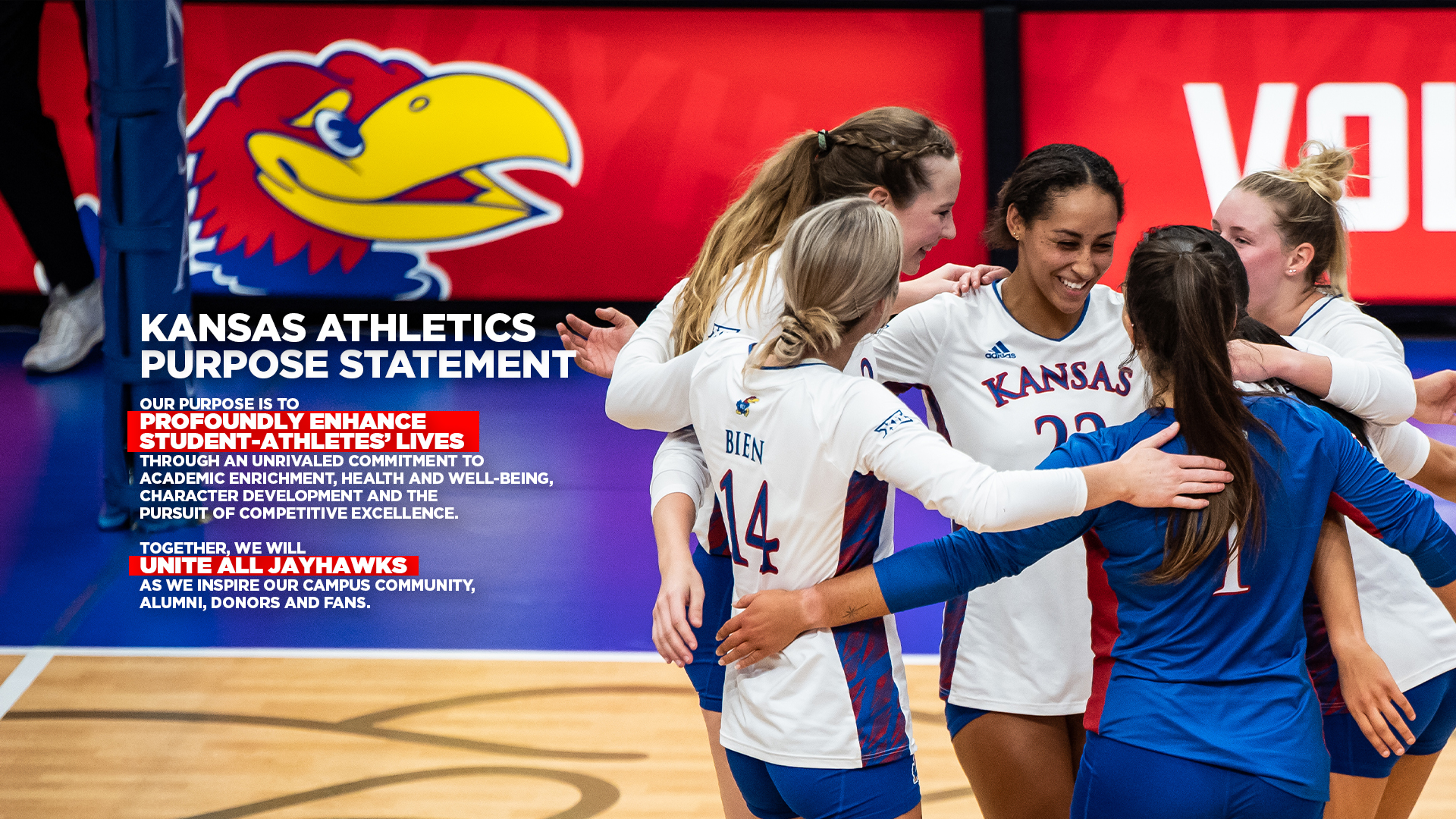
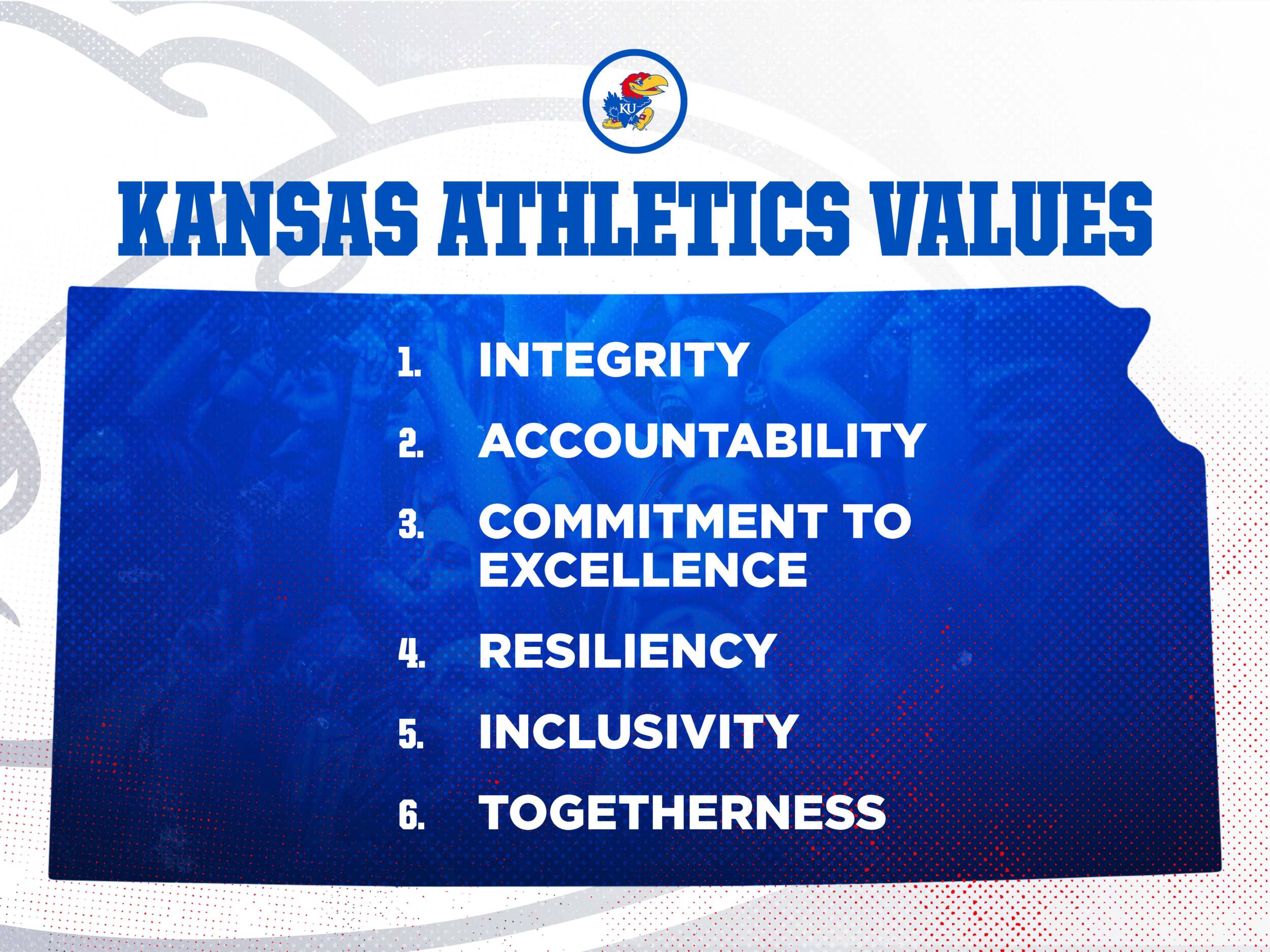
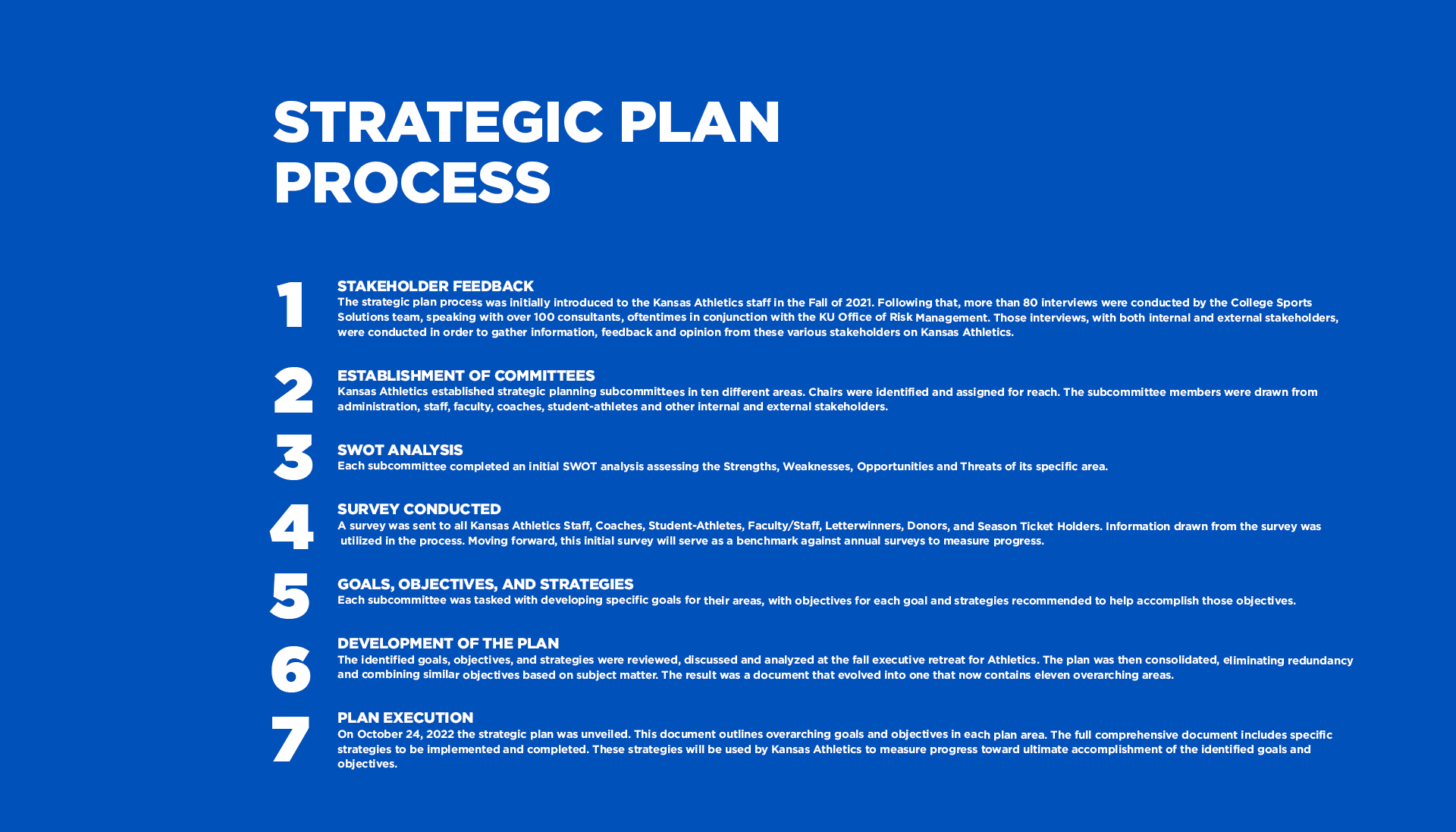
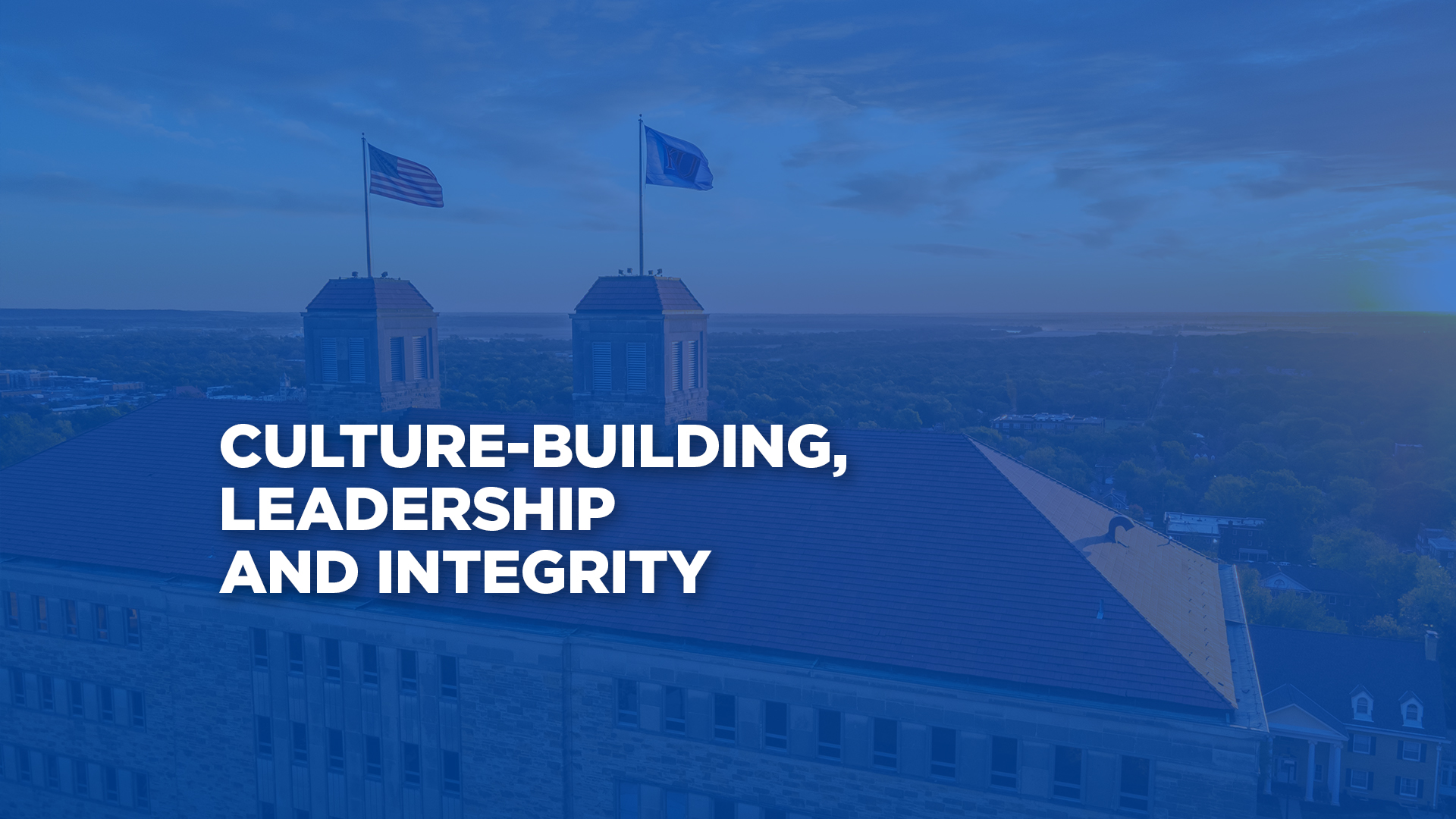
Culture-Building, Leadership and Integrity Goals
1 – Finalize the Kansas Athletics Values and establish a Culture Ambassador team.
★ Objective 1: Define and culturally integrate the nine Kansas Athletics’ Values.
★ Objective 2: Develop additional staff team-building opportunities.
2 – Provide opportunities, training and development for leadership roles for staff.
★ Objective 1: Develop robust leadership roles within University, Conference, NCAA and other sports and leadership groups, increasing engagement with such organizations.
★ Objective 2: Create a leadership academy.
3 – Nurture leadership opportunities for student-athletes.
★ Objective 1: Nurture leadership development and professional development through best-in-class programs and initiatives.
★ Objective 2: Ensure KU LEADS can connect with student-athletes in the hopes that they will seek more help from opportunities KU LEADS offers.
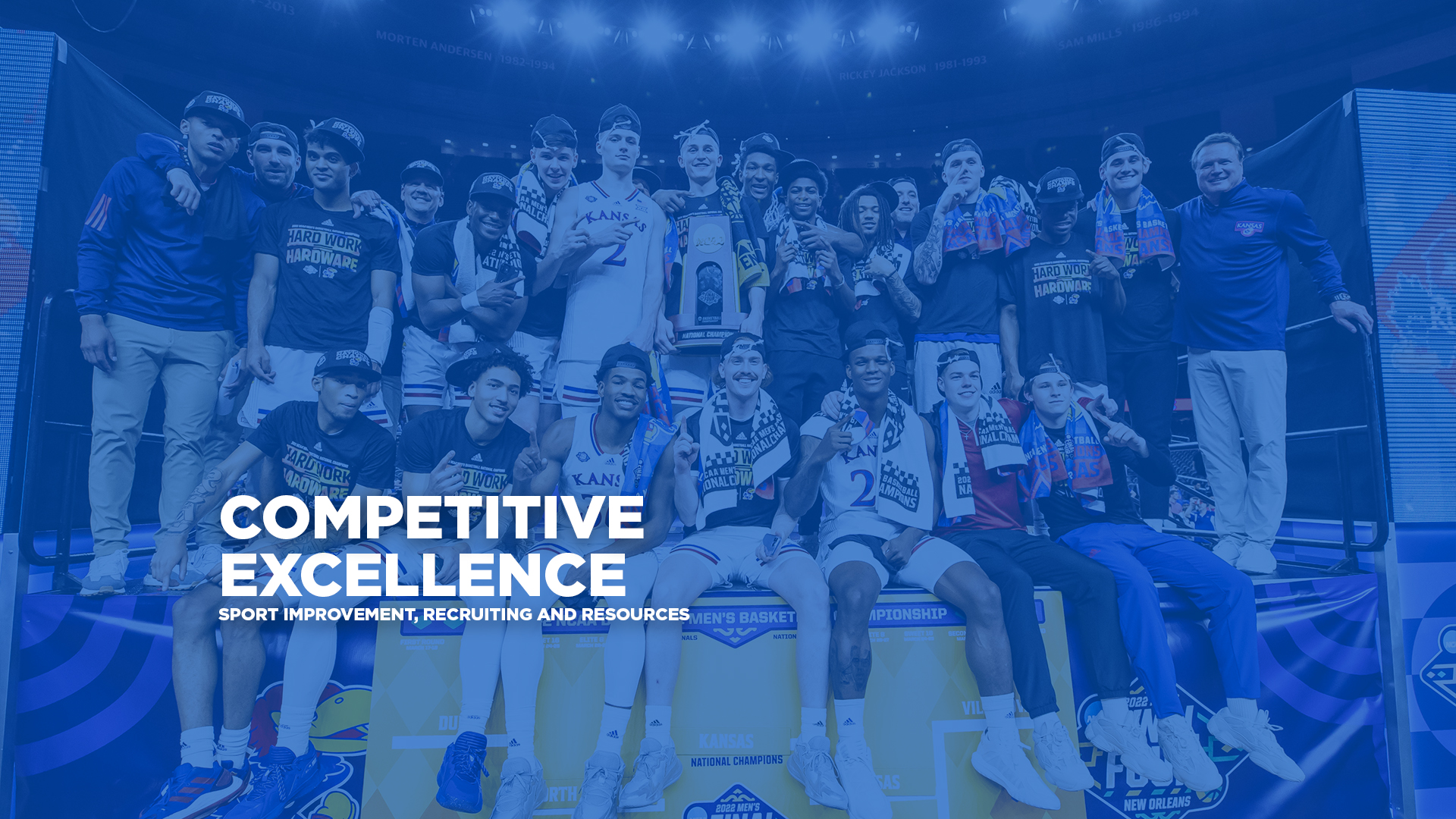
Competitive Excellence Goals
1 – Foster a culture that promotes competitive excellence by providing Jayhawk coaches and student-athletes the opportunity to win championships, achieve post-season success and attain national recognition in all sport programs.
★ Objective 1: Develop clear expectations for each sport program that supports annual improvement in athletic performance and enhance the department’s national recognition.
★ Objective 2: Develop sport-specific, five-year performance plans designed to assess program metrics, priorities and areas for improvement.
2 – Maximize recruiting efforts to attract elite student-athletes by creating a culture of excellence and distinction in all that we do.
★ Objective 1: Invest in recruiting infrastructure unique to sport program needs.
3 – Maximize financial resources to support sport program success.
★ Objective 1: Maximize the resources available to support student-athletes and coaches (e.g., training table, nutrition, and enhanced equipment).
★ Objective 2: Prioritize a competitive salary and benefits structure that allows us to attract and retain exceptional coaches and staff.
★ Objective 3: Annually assess and improve travel budgets to align program priorities and department expenses (e.g., training trips to compete against the best competition).
★ Objective 4: Continue to invest in the Alston Academics Award while striving to distribute the maximum amount to all scholarship student-athletes.
★ Objective 5: Develop customized marketing/fan engagement plans to continually grow attendance for all programs, in order to create the best possible “home-field” advantage.
4 – Relentlessly invest in and support Kansas Football in order to accomplish our strategic goals and build a sustained successful program.
★ Objective 1: Transform Anderson Family Football Complex and David Booth Kansas Memorial Stadium in order to provide world class facilities that will attract and develop top-tier student-athletes.
★ Objective 2: Recruit and retain elite coaches and staff by providing competitive compensation, a strong culture and a commitment to excellence.
★ Objective 3: Provide significant NIL support and resources to create opportunities for Kansas Football student-athletes.
5 – Vigorously invest in Kansas Men’s Basketball in order to sustain and enhance its unprecedented legacy of success and University-wide impact.
★ Objective 1: Invest in Allen Fieldhouse to provide significant upgrades to the best atmosphere in college basketball.
★ Objective 2: Recruit and retain elite coaches and staff by providing competitive compensation, a strong culture and a commitment to excellence.
★ Objective 3: Provide significant NIL support and resources to create opportunities for Kansas Basketball student-athletes.

Capital Projects Goals
1 – Invest in ALL facilities and infrastructure in order to position Kansas Athletics’ facilities portfolio amongst the best in the Big 12 and top-25 in the country.
★ Objective 1: Develop a 10-year comprehensive sport-specific facilities master plan that outlines capital priorities, improvements and costs.
★ Objective 2: Construct, operate and maintain safe facilities.
★ Objective 3: Prioritize capital projects to align program priorities, with facility needs and department expenditure.
★ Objective 4: Develop fundraising strategies and explore other revenue generation opportunities to support sport-specific facility needs.
★ Objective 5: Dramatically improve wifi opportunities throughout all venues.
★ Objective 6: Design and renovate facilities that match our financial resources.
2 – David Booth Kansas Memorial Stadium
★ Objective 1: Transform the game-day experience for our fans through a reimagined seating bowl design; expanded concessions, restrooms and accessible seating locations; improved concourse circulation; and new and diverse premium amenities.
★ Objective 2: Create year-round usable space for more large scale activities which drive economic impact to the community .
3 – Anderson Family Football Complex
★ Objective 1: Maximize the day-to-day, holistic experience for Jayhawk football student-athletes through enhanced spaces dedicated to sports performance, nutrition, sports medicine, meeting rooms and technology, and recruiting and culture-building space.
★ Objective 2: Maximize efficiencies and space utilization by integrating elements of Anderson Family Football Complex and David Booth Kansas Memorial Stadium.
4 – Allen Fieldhouse Renovation
★ Objective 1: Enhance in-game, in-seat experience through new technology (videoboard(s), lighting, sound system).
★ Objective 2: Improve overall fan experience through concourse renovations (concessions, restrooms, aesthetics, branding) and team store expansion.
★ Objective 3: Augment premium hospitality spaces to rival the best in college basketball.
5 – Hoglund Ballpark Renovation
★ Objective 1: Improve the student-athlete experience through a renovated locker room and new player lounge.
★ Objective 2: Evaluate, plan and create a funding path for a significant reimagination of the stadium, focused on fan experience.
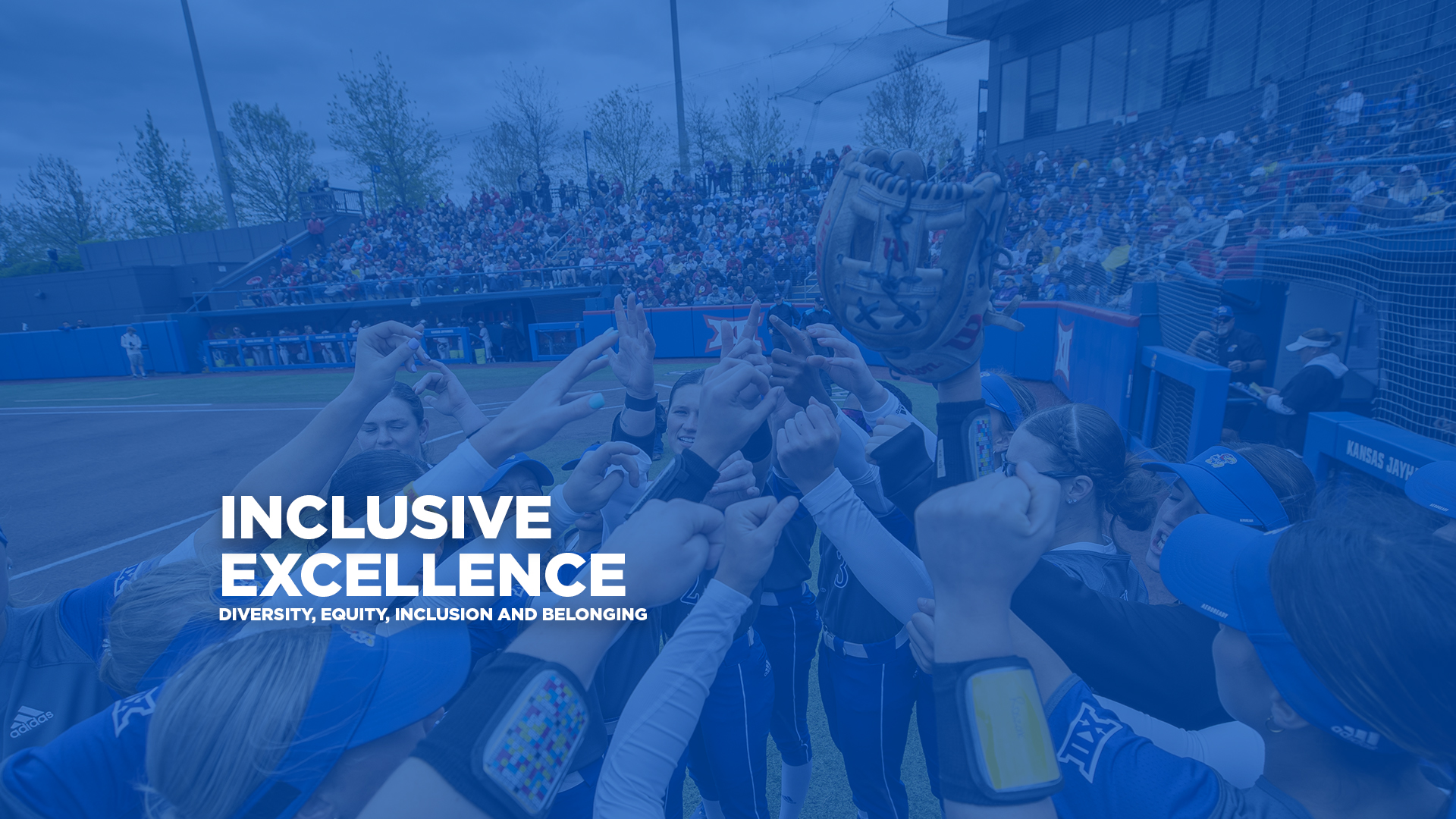
Inclusive Excellence Goals
1 – Develop an Inclusive Excellence framework that supports Kansas Athletics’ pursuit of diversity, equity, inclusion, and belonging (DEIB) while contributing to the greater university’s aspiration to foster Healthy & Vibrant Communities.
★ Objective 1: Leverage the Diversity Leadership Council to support the overall sustainability of the Inclusive Excellence framework.
★ Objective 2: Enhance funding opportunities to support Kansas Athletics DEIB Initiatives:
★ Objective 3: Utilize feedback and monitor societal evolution to identify opportunities for Kansas Athletics DEIB to progress.
★ Objective 4: Demonstrate Inclusive Excellence.
2 – Improve the current infrastructure to cultivate a belonging community for all coaches and staff.
★ Objective 1: Enhance current coach and staff programming to foster conversations focused on DEIB via the Staff Initiatives Committee of the Diversity Leadership Council.
★ Objective 2: Increase the diverse representation of student-athlete-facing personnel positions by 10% by August 1, 2024 by focusing on recruitment, hiring, and retention of diverse identities.
3 – Provide opportunities for student-athletes to develop their community, their voice, and their support infrastructures.
★ Objective 1: Create opportunities for student-athlete body to organically build camaraderie.
★ Objective 2: Create additional spaces where student-athletes can voice their needs and wins beyond REAL RESPONSE, the annual Senior Exit and Transfer Interview process, and he annual student-athlete surveys.
★ Objective 3: Nurture student-athlete communities that focus on the spectrum of student-athlete identities.
4 – Contribute to the university’s cultivation of Healthy & Vibrant Communities by creating intentional opportunities that unite our athletics department, campus, the greater Lawrence community and Jayhawks from around the world (i.e. the Jayhawk Community).
★ Objective 1: Strengthen the local and global Jayhawk communities.
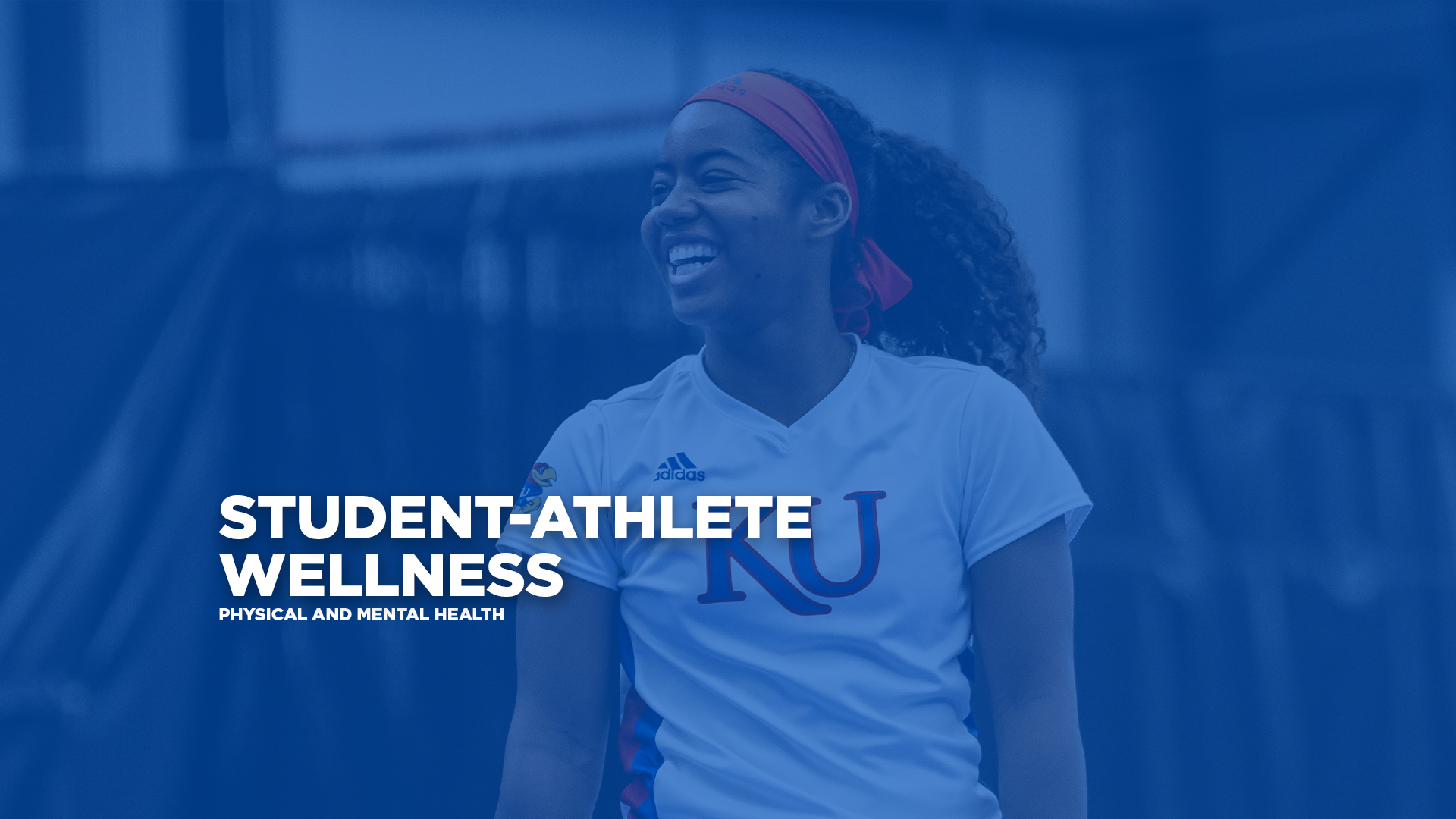
Student-Athlete Wellness Goals
1 – Provide student-athletes with resources, access to support and tools to be healthy and achieve success.
★ Objective 1: Support their personal growth, independence and self-advocacy.
★ Objective 2: Ensure that student-athletes understand resources available for their health and wellness and how to access them.
2 – Implement a comprehensive approach to student-athlete health, safety and well-being.
★ Objective 1: Following guidelines set by Kansas Team Health, bring a comprehensive approach to student-athlete care.
★ Objective 2: When injury or extended illness occur, implement effective communication process for student-athlete’s understanding of their condition, prognosis, and expectations for return to activity.
★ Objective 3: Contribute to the development of health and wellness throughout the Jayhawk Community.
3 – Provide comprehensive mental health support services to student-athletes evolving and expanding mental health support and outreach based on their needs.
★ Objective 1: Annually and anonymously review the usage of mental health services by student-athletes, in order to identify any trends and gaps in service.
★ Objective 2: Meet student-athletes “where they are” to deliver resources and support.
★ Objective 3: Participate in efforts to remove the stigma that keeps some student-athletes, especially males, from seeking mental health support.
★ Objective 4: Ensure coaches and support staff, working closely with student-athletes, understand the resources available for wellness and how to best support student-athletes.
4 – Regularly monitor Kansas Team Health Support Structure, staffing levels and expertise provided to ensure student-athlete and team needs are met appropriately and that we remain competitive with our counterparts.
★ Objective 1: Maintain continuity of care and support with essential Kansas Team Health staff.
5 – Continue to assess Kansas Team Health’s strengths, weaknesses, opportunities, as well as threats to student-athlete wellness; adapt as needed.
★ Objective 1: Review on a continuous basis all elements that impact student-athlete wellness, noting changes which could impact overall success and well-being.
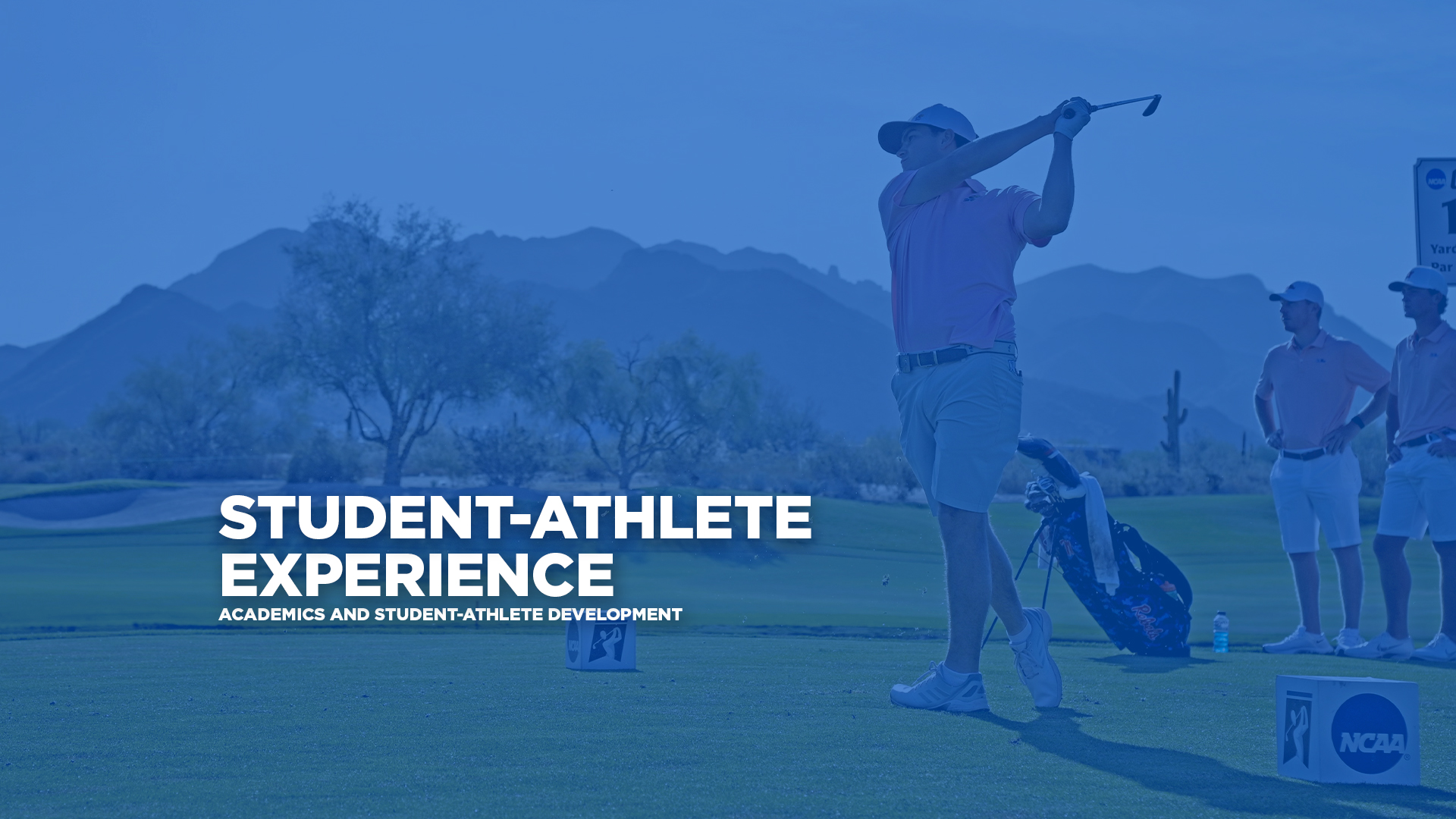
Student-Athlete Experience Goals
1 – Continually place in the top-third of the conference and the country for Graduation Success Rate and Academic Progress Rate, while qualifying annually for the NCAA Academic Revenue Distribution.
★ Objective 1: Consistently rank at the top in terms of the academic measurements and to recognize the achievements of our student-athletes in these areas on a national level.
2 – Provide comprehensive support to student-athletes from recruitment to graduation and beyond through collaboration, an inclusive learning environment, and expanding programming.
★ Objective 1: Enhance programming to assist student-athletes successfully transition post-eligibility.
3 – Provide exceptional academic support to student-athletes.
★ Objective 1: Student-Athlete Support Services will build an infrastructure that promotes an environment of excellence and integrity and first-class opportunities for staff.
★ Objective 2: Enhance the role of Academic and Career Counselors.
★ Objective 3: Provide the finest learning services support to student-athletes and maintain an environment of integrity, inclusion and academic success.
4 – Continue to offer community building initiatives and educational opportunities through student-athlete development program (KU Leads).
★ Objective 1: Support Jayhawk student-athletes in a critical time in their personal development by offering best-in-class student-athlete development programs.
5 – Provide student-athletes with the crucial technology needed to be successful at a high level.
★ Objective 1: Provide an expansive laptop program, with increased opportunities for additional technology.
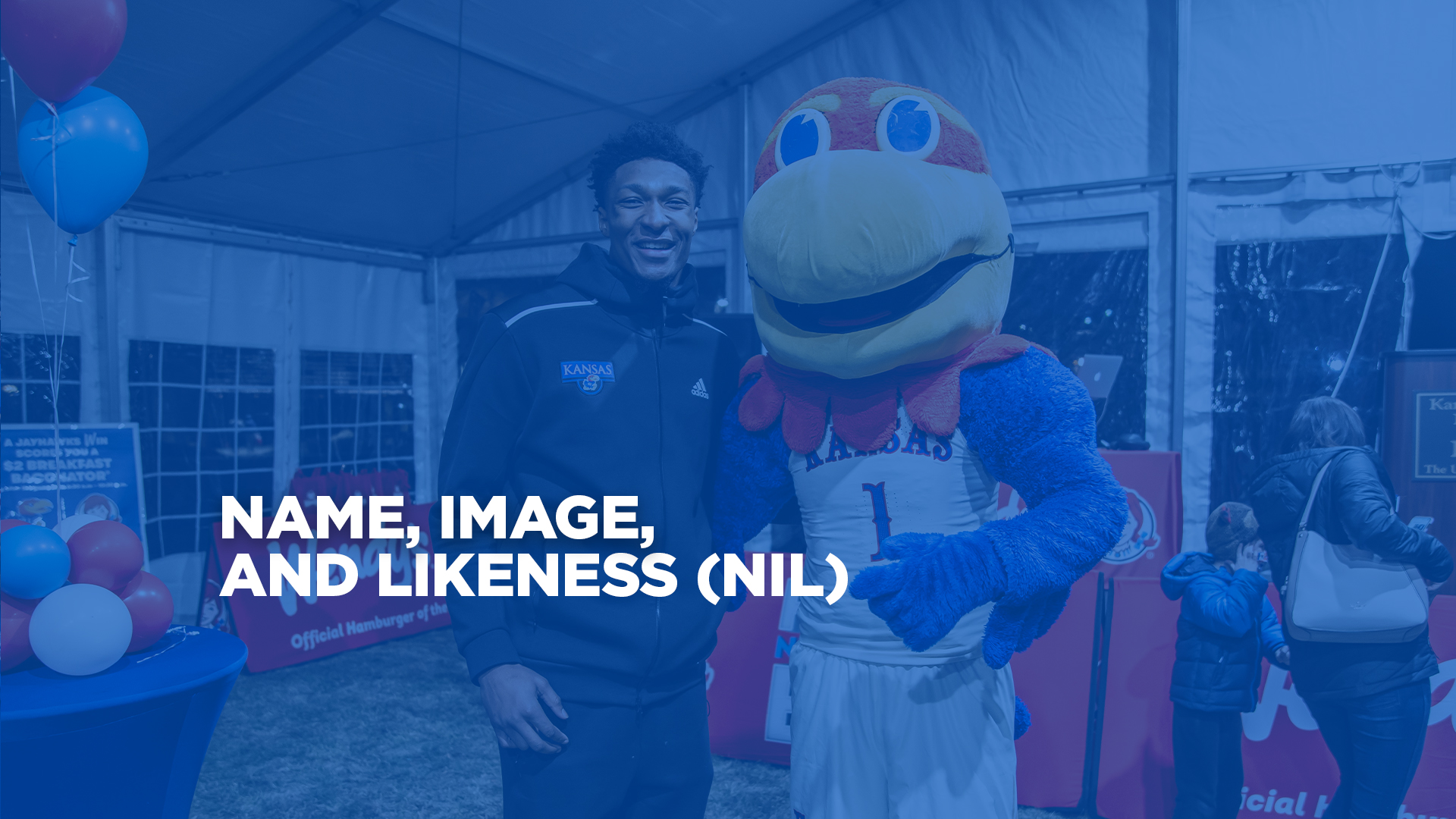
Name, Image, and Likeness Goals
1 – Implement the four pillars of Jayhawks Ascend (Personal Brand Management; NIL Protection; KU Resource Engagement; Post KU Preparedness) in order to provide KU Student-Athletes with best-in-class support in this critical and evolving space.
★ Objective 1: Maximize current resources within Kansas Athletics and external partners to make sure we are staying competitive and educating our internal and external stakeholders.
★ Objective 2: Continue to grow licensed NIL opportunities by another 25% in the next two years (minus national championship sales).
★ Objective 3: Commitment to collaboration and innovation in the NIL space by developing two new innovative ways to engage with our fans that make a long-term impact on KU Athletics within the next three years, aligning with the understanding that each team and athlete may want different NIL opportunities.
★ Objective 4: Prepare student-athletes for the new financial challenges that NIL may bring.
2 – Utilize internal and external resources to best position the NIL infrastructure for our student-athletes.
★ Objective 1: Empower the Directors of NIL to be innovative and progressive in the NIL landscape.
★ Objective 2: Put an emphasis on internal working groups that focus specifically on football, men’s basketball, women’s basketball and Olympic sports.
★ Objective 3: Lean on our third-party experts (Altius, Opendorse), to provide insights and protection in the NIL space.
3 – Continue to educate our constituents about NIL and the impact it has on competitive excellence and the student-athlete experience.
★ Objective 1: We will consistently communicate with our constituents on the latest trends of NIL and the resources we are providing for our Student-Athletes.

Engagement Goals
1 – Further the athletic department’s connection and relationship with the greater campus community.
★ Objective 1: Enhance communication and collaboration with faculty and staff.
★ Objective 2: Establish new and expanded initiatives to grow the campus and athletics relationships.
★ Objective 3: Connect student-athletes with the general student body to continue to foster an environment that creates opportunities for further connection and University morale.
★ Objective 4: Support the University of Kansas higher learning environment by supporting two scholarly-based campus initiatives annually.
2 – Create collaborative integrations with campus partners including but not limited to KU Endowment, KU Alumni Association, KU campus leadership, faculty/staff and student organizations that promotes togetherness while generating increased resources to benefit these relationships.
★ Objective 1: Create a minimum of two new programs or platforms annually over the next three years with campus partners that helps elevate community engagement, positive brand association, and alumni/fan communication and outreach.
★ Objective 2: Explore opportunities to integrate alumni and fan data across all campus platforms creating better communication and engagement that will better serve our shared constituents.
★ Objective 3: Create cross-channel content and event opportunities that highlight campus and athletics collaboration initiatives to better tell our mutual stories, which will aid in increased enrollment and a sense of pride in our campus community.
3 – Develop an enhanced and seamless fan experience that encompasses all touchpoints, including purchase process, venue experience, and department follow-up.
★ Objective 1: Maintain a clear focus on the buying process for fans to ensure ease of purchase with a streamlined flow, eliminating barriers.
★ Objective 2: Improve and enhance the game day experience through creative and refreshed programming and customer service opportunities while keeping traditions intact.
★ Objective 3: Continue to develop fan feedback initiatives post-event through surveys and other data capture activities including fan appreciation.
4 – Develop a comprehensive communications platform that generates positive brand associations through storytelling, marketing, community outreach, video and social/digital strategies, while increasing revenue and providing needed resources to our student-athletes, coaches and staff.
★ Objective 1: Utilize storytelling to build positive brand association and engagement on a local, regional, and national level of the athletics department, staff, coaches, and student-athletes. This must be a collaborative effort from head coaches, support staff, sport administrators, Rock Chalk Video, and LEARFIELD Studios to identify and create impactful stories that represents KU, its history and its future.
★ Objective 2: Develop a comprehensive and innovative digital growth plan that is viewed nationally as a leader in innovation.
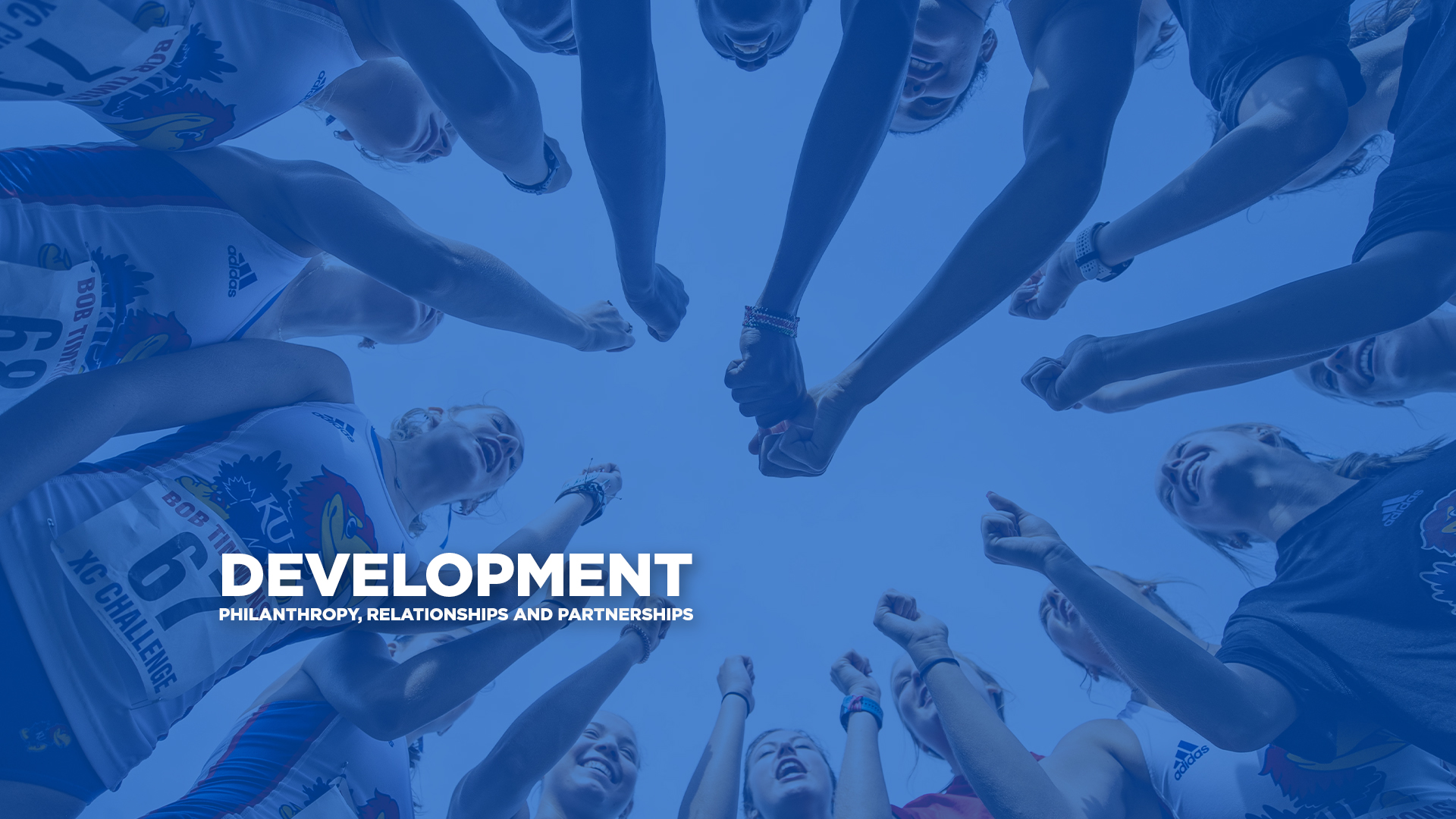
Development Goals
1 – Improve and enhance our culture of philanthropy.
★ Objective 1: Develop and articulate a strong vision for philanthropic opportunities and impact within Kansas Athletics.
★ Objective 2: Restructure the framework of the development operation.
★ Objective 3: Educate internal and external stakeholders about new Kansas Athletics Development framework.
2 – Enhance Strategic Development Partnerships.
★ Objective 1: Increase internal stakeholders’ awareness of and engagement with the Kansas Athletics Development operation.
★ Objective 2: Increase the awareness of the value of interdependence among campus partners with respect to development efforts and fundraising initiatives.
★ Objective 3: Increase the engagement of K-Club (all former student-athletes, head coaches, trainers and managers) with KU.
3 – Increase, Diversify, and Broaden Development Efforts.
★ Objective 1: Improve and increase utilization of data to expand donor pipeline at all levels of giving.
★ Objective 2: Increase retention and growth rates of existing donor participation.
★ Objective 3: Engage and educate lapsed donors to inspire them to renew their support.
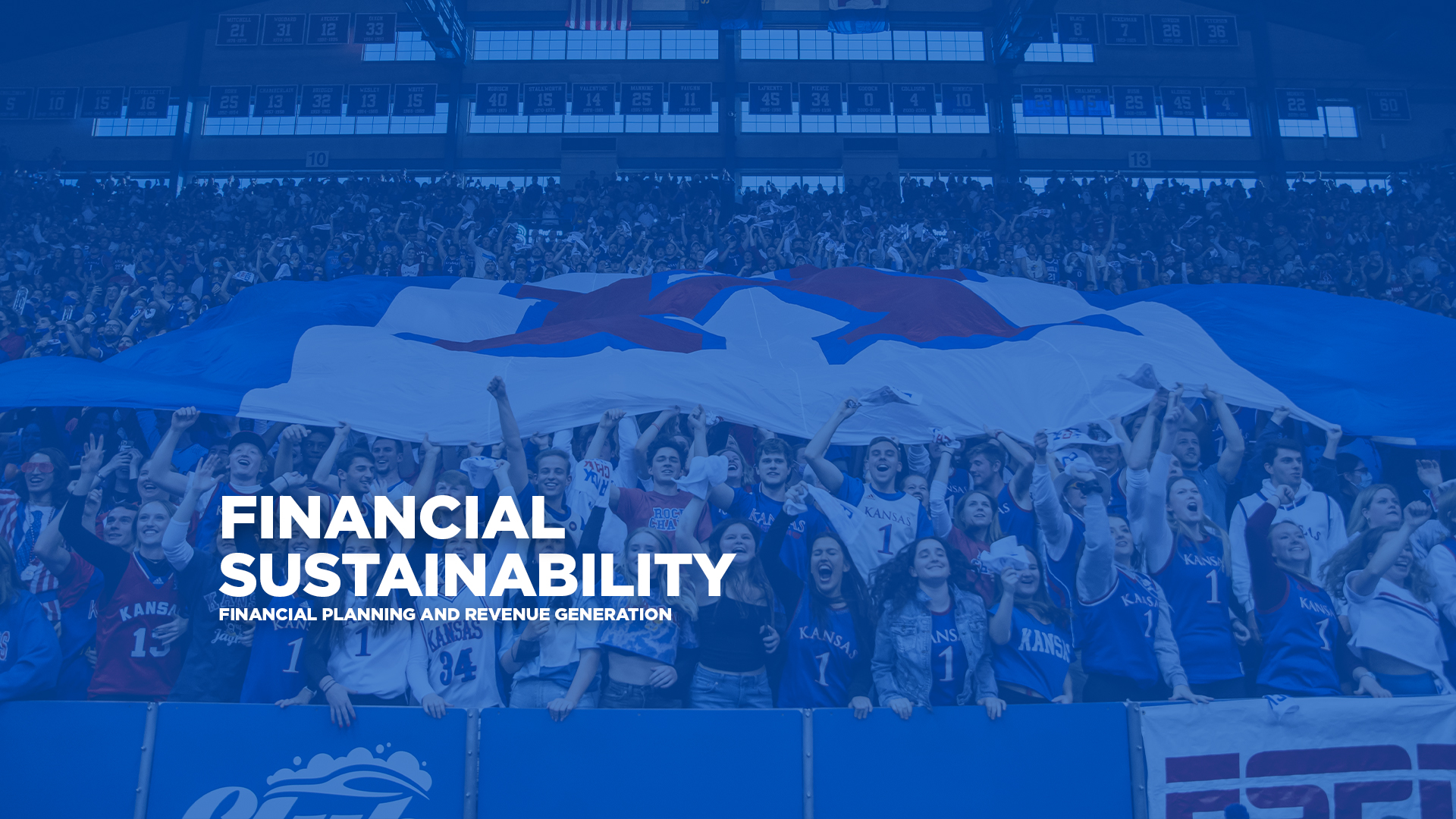
Financial Sustainability Goals
1 – Carry out Kansas Athletics operational activities in a prioritized and fiscally responsible manner.
★ Objective 1: Complete annual planning, budgeting, forecasting and reporting.
★ Objective 2: Maintain a commitment to expense management where spending is focused on student-athlete experience and initiatives that create a return on investment.
2 – Achieve revenue growth through strategic corporate partnerships that simultaneously align with department and campus units while elevating brand awareness in local, regional, and national audiences.
★ Objective 1: Annual examination of sales strategies and go to market platforms to grow revenues by an average of 8% year over year.
★ Objective 2: Develop sales platforms that included IP rights (use of the Jayhawk marks and logos).
3 – Develop comprehensive revenue and fan experience plan leveraging the 11th & Mississippi Project to provide transformational resources to Kansas Athletics and the greater campus and Lawrence community.
★ Objective 1: Create premium seating sales strategy that will generate needed resources for project completion.
4 – Increase overall department variable revenue utilizing and leveraging strategic partners to control the ticket market and capitalize on data-driven decisions and efficiencies.
★ Objective 1: Renew all ticketing sports and WEF annual contributions at 88% or higher on an annual basis.
★ Objective 2: Develop a comprehensive strategy utilizing Event Dynamic and Data Platforms to drive new revenue and attendance for all ticketed sports.
★ Objective 3: Execute a licensing plan that will put us consistently in the Top-20 of CLC licensed schools in revenue and Top-25 of Fanatics online sales nationally.
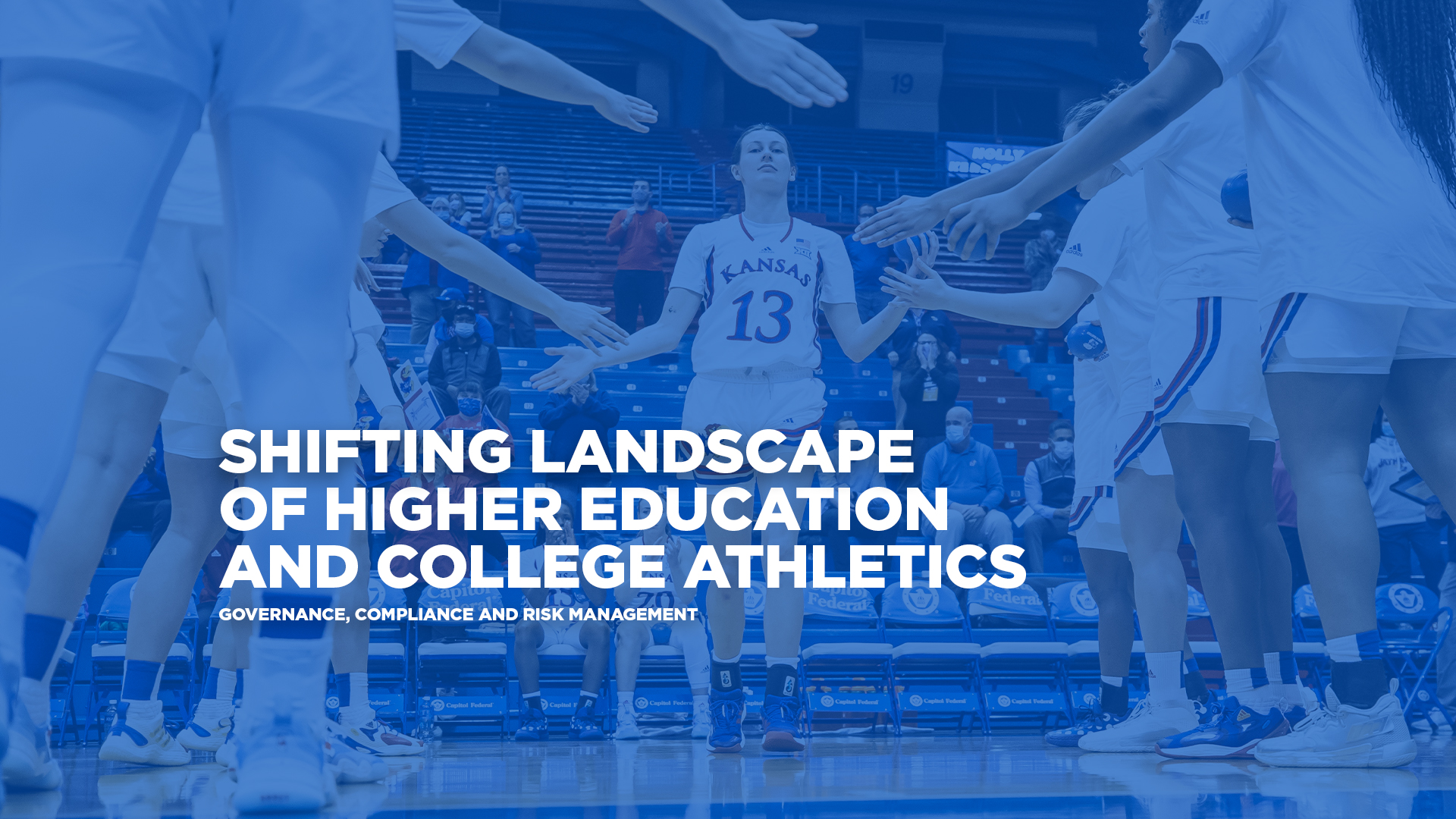
Shifting Landscape of Higher Education and College Athletics
1 – Develop a robust presence in University, Conference and NCAA governance communities aligning with their policies, procedures, and strategic plan goals to enhance and develop out interactions and leadership within the campus, conference and NCAA landscapes.
★ Objective 1: Educate staff and ensure alignment, application, and understanding of Kansas Athletics policies and procedures with campus, conference and NCAA policies.
2 – Maintain a robust compliance program aligned with University, Conference and NCAA best practices while providing outstanding support to key stakeholders, including student-athletes and their families, coaches, staff, donors, alumni and fans.
★ Objective 1: Create a regular process to evaluate current compliance processes and support levels remain appropriate within the changing context of athletics and higher education.
★ Objective 2: Staff with compliance responsibilities will be seen as integrated partners within all teams and departments, valued for excellent service and external stakeholders.
★ Objective 3: Increase Kansas Athletics engagement with University compliance and enterprise risk management.
3 – Develop and grow risk management efforts across the athletics enterprise, aligned with University risk management processes.
★ Objective 1: Strategically position athletics risk management initiatives to support the University of Kansas strategic plan and key University affiliates.
